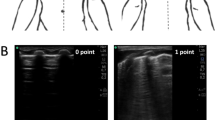Abstract
Objective
Assess the earliest time of LUS to guide surfactant therapy.
Study design
In this observational study (ClinicalTrials.gov Identifier NCT04544514), LUS was performed within 30 min and repeated at 1, 2, 4, and 6 h on preterm babies. White lung appearance was defined as type 1 group, whereas prevalence of lines B as type 2 and lines A as type 3. Ultrasound and radiographic findings were also compared to determine surfactant need.
Results
Among 71 patients, 41 received surfactant therapy. In the first evaluation, 37 of them have been defined as type 1, whereas 4 of them have been as type 2 group. Type 3 group did not receive surfactant. Type 1 findings were superior to predict surfactant need and the predictive value was 100% at 2 h.
Conclusion
Even early LUS assessment at the first 20–30 min was more significant to predict surfactant need than x-ray. Presence of white lung appearance for 2 h indicates an absolute surfactant need.
This is a preview of subscription content, access via your institution
Access options
Subscribe to this journal
Receive 12 print issues and online access
$259.00 per year
only $21.58 per issue
Buy this article
- Purchase on Springer Link
- Instant access to full article PDF
Prices may be subject to local taxes which are calculated during checkout




Similar content being viewed by others
References
Sweet DG, Carnielli V, Greisen G, Hallman M, Ozek E, te Pas A, et al. European consensus guidelines on the management of respiratory distress syndrome—2019 update. Neonatology. 2019;115:432–51.
Rojas-Reyes MX, Morley CJ, Soll R. Prophylactic versus selective use of surfactant in preventing morbidity and mortality in preterm infants. Cochrane Database Syst Rev. 2012;3:CD000510.
Bahadue FL, Soll R. Early versus delayed selective surfactant treatment for neonatal respiratory distress syndrome. Cochrane Database Syst Rev. 2012;11:CD001456.
Polin AP, Carlo WA. Committee on fetus and newborn. surfactant replacement therapy for preterm and term neonates with respiratory distress. Pediatrics. 2014;133:156–63.
Woods PL. Utility of lung ultrasound scanning in neonatology. Arch Dis Child. 2019;104:909–15.
Copetti R, Cattarossi L, Macagno G, Violino M, Furlan R. Lung ultrasound in respiratory distress syndrome: a useful tool for early diagnosis. Neonatalogy. 2008;94:52–59.
Raimondi F, Cattarossi L, Copetti R. Point-of-care ultrasound in the neonatal intensive care unit: an Italian perspective. NeoReviews. 2014;15:e1–5.
Cattarossi L. Lung ultrasound: its role in neonatology and pediatrics. Early Hum Dev. 2013;89S1:S17–19.
Raimondi F, Migliaro F, Sodano A, Ferrara T, Lama S, Vallone G, et al. Use of neonatal chest ultrasound to predict noninvasive ventilation failure. Pediatrics. 2014;134:e1089–94.
Raimondi F, Migliaro F, Sodano A, Umbaldo A, Romano A, Vallone G, et al. Can neonatal lung ultrasound monitor fluid clearance and predict the need of respiratory support? Crit Care. 2012;16:R220.
Escourrou G, De Luca D. Lung ultrasound decreased radiation exposure in preterm infants in a neonatal intensive care unit. Acta Paediatr. 2016;105:e237–9.
Liu J, Cao HY, Wang HW, Kong XY. The role of lung ultrasound in diagnosis of respiratory distress syndrome in newborn infants. Iran J Pediatr. 2014;24:147–54.
El-Malah HEDGM, Hany S, Mahmoud MK, Ali AM. Ultrasonography in evaluation of neonatal respiratory distress syndrome. Egypt J Radiol Nucl MEd. 2015;46:469–74.
Bober K, Swietlinski J. Diagnostic utility of ultrasonography for respiratory distress syndrome in neonates. Med Sci Monit. 2006;12:Cr440–6.
Kurepa D, Zaghloul N, Watkins L, Liu J. Neonatal lung ultrasound exam guidelines. J Perinatol. 2018;38:11–22.
Vergine M, Copetti R, Brusa G, Cattarossi L. Lung ultrasound accuracy in respiratory distress syndrome and transient tachypnea of the newborn. Neonatology. 2014;106:87–93.
De Martino L, Yousef N, Ben-Ammar R, Raimondi F, Shankar-Aguilera S, De Luca D. Lung ultrasound score predicts surfactant need in extremely preterm neonates. Pediatrics. 2018;142:e20180463.
Brat R, Yousef N, Klifa R, Reynaud S, Shankar Aguilera S, De Luca D. Lung ultrasonography score to evaluate oxygenation and surfactant need in neonates treated with continuous positive airway pressure. JAMA Pediatr. 2015;169:e151797.
Gregorio-Hernandez R, Arriaga-Redondo M, Perez-Perez A, Ramos-Navarro C, Sanchez-Luna M. Lung ultrasound in preterm infants with respiratory distress: experience in a neonatal intensive care unit. Eur J Pediatr. 2020;179:81–89.
Raschetti R, Yousef N, Vigo G, Marseglia G, Centorrino R, Ben-Ammar R, et al. Echography-guided surfactant therapy to improve timeliness of surfactant replacement: a quality improvement project. J Pediatr. 2019;212:137–43.
Pang H, Zhang B, Shi J, Zang J, Qiu L. Diagnostic value of lung ultrasound in evaluating the severity of neonatal respiratory distress syndrome. Eur J Radiol. 2019;116:186–91.
Perri A, Riccardi R, Iannotta R, di Molfetta DV, Arena R, Vento G, et al. Lung ultrasonography score versus chest X-ray score to predict surfactant administration in newborns with respiratory distress syndrome. Pediatr Pulmonol. 2018;53:1231–6.
Blank DA, Rogerson SR, Kamlin COF, Fox LM, Lorenz L, Kane SC, et al. Lung ultrasound during the initiation of breathing in healthy term and late preterm infants immediately after birth, a prospective, observational study. Resuscitation. 2017;114:59–65.
Blank DA, Kamlin COF, Rogerson SR, Fox LM, Lorenz L, Kane SC, et al. Lung ultrasound immediately after birth to describe normal neonatal transition: an observational study. Arch Dis Child Fetal Neonatal Ed. 2018;103:F157–62.
Arthur R. The neonatal chest X-ray. Pediatr Respir Rev. 2001;2:311–23.
Author information
Authors and Affiliations
Corresponding author
Ethics declarations
Conflict of interest
The authors declare no competing interests.
Additional information
Publisher’s note Springer Nature remains neutral with regard to jurisdictional claims in published maps and institutional affiliations.
Rights and permissions
About this article
Cite this article
Kayki, G., Yigit, S., Tandircioglu, U.A. et al. Lung ultrasound (LUS) and surfactant treatment: looking for the best predictive moment. J Perinatol 41, 1669–1674 (2021). https://doi.org/10.1038/s41372-021-01039-0
Received:
Revised:
Accepted:
Published:
Issue Date:
DOI: https://doi.org/10.1038/s41372-021-01039-0
This article is cited by
-
Lung ultrasonography decreases radiation exposure in newborns with respiratory distress: a retrospective cohort study
European Journal of Pediatrics (2022)



